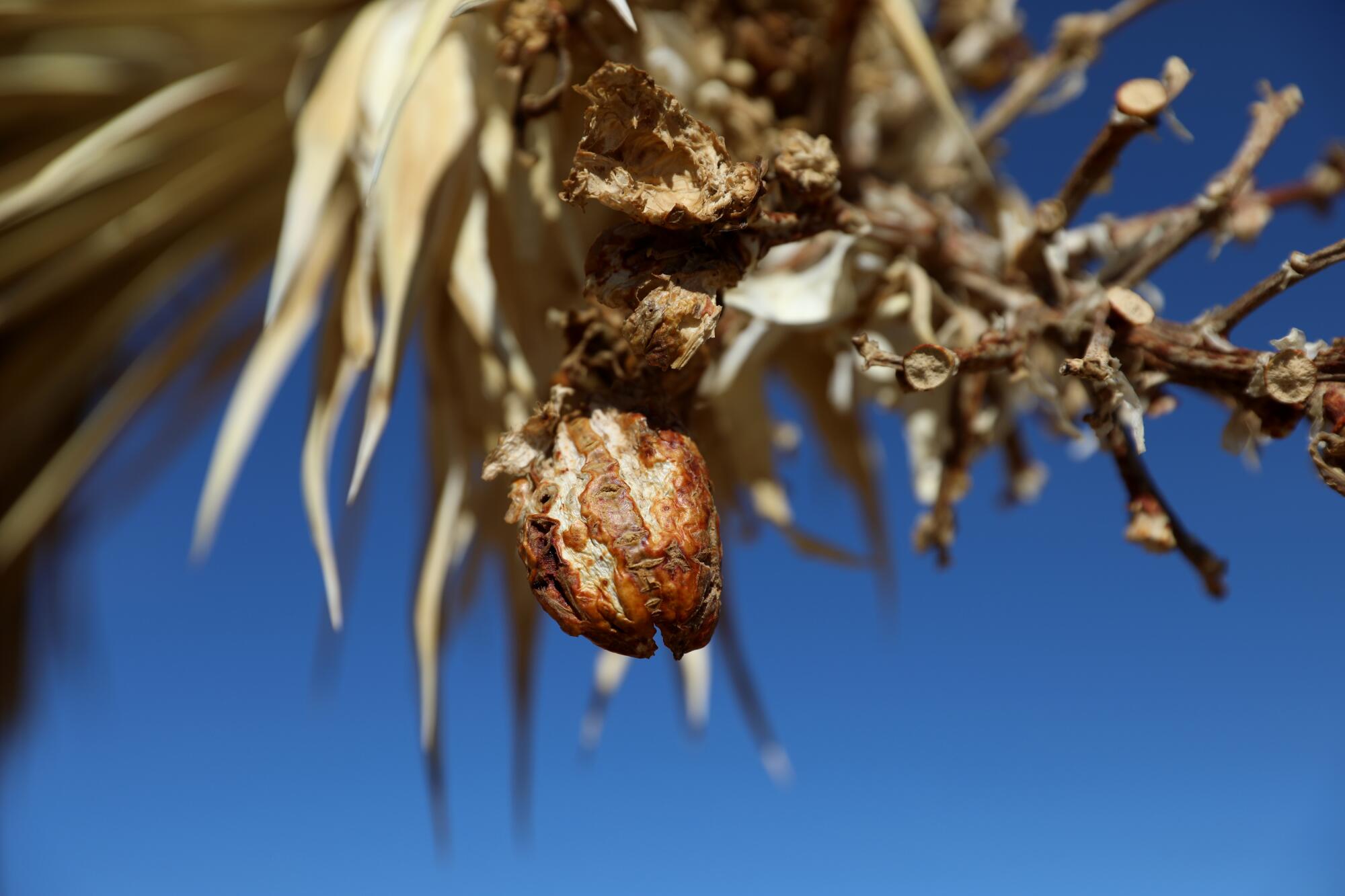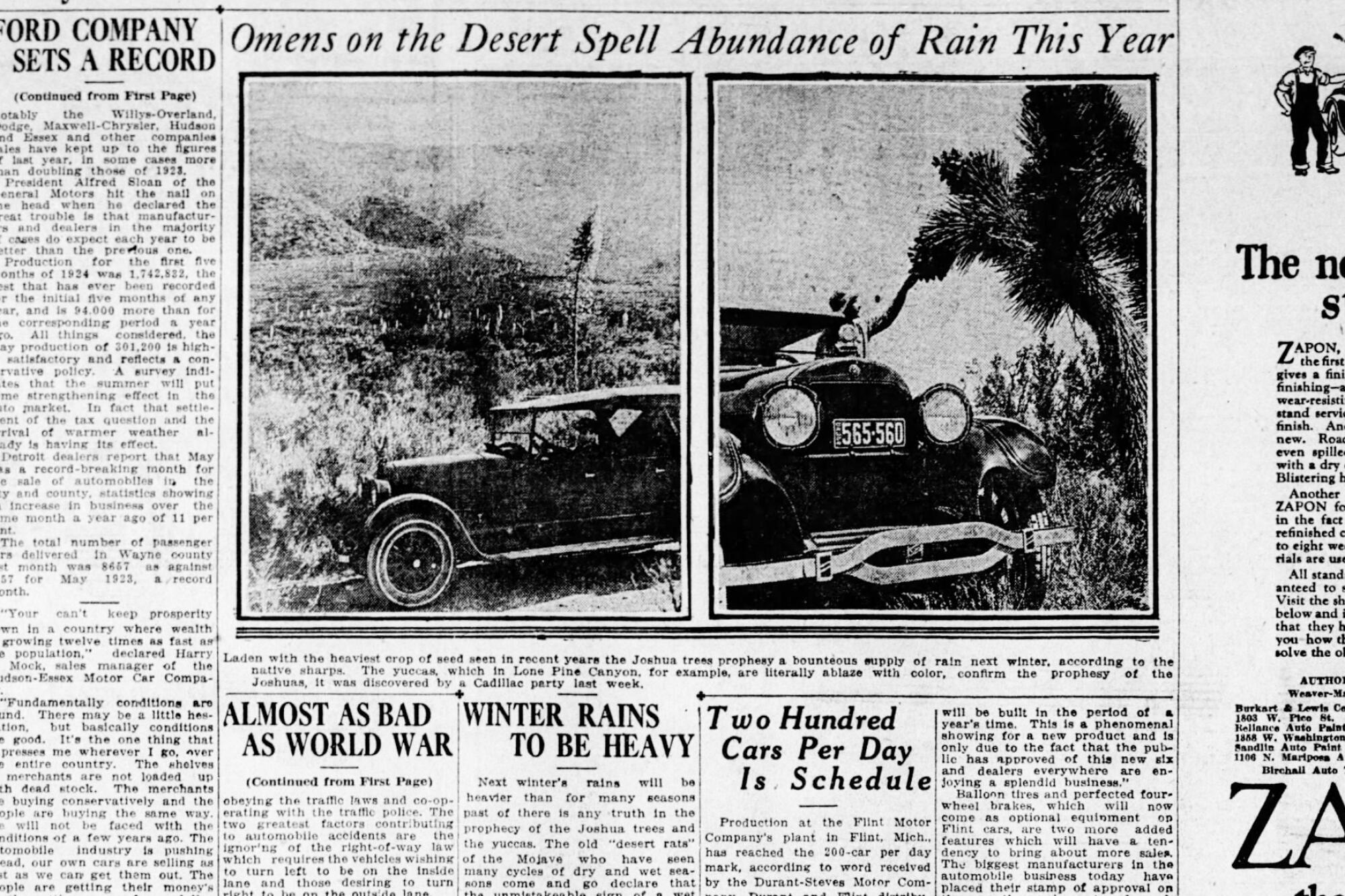-
San Diego sheriff: Migrants did not try to forcefully stop school bus - August 31, 2024
-
One stabbed, another injured in altercation on L.A. Metro bus - August 31, 2024
-
Trump Judge Has ‘Two Options’ as Future of Case Unclear: Analyst - August 31, 2024
-
What to Know About Putin’s Planned Visit to Mongolia Amid ICC Arrest Warrant - August 31, 2024
-
Buying sex from a minor could be a felony under bill headed to Newsom - August 31, 2024
-
Democrat Lawmaker Switches Party to Become Republican - August 31, 2024
-
Misdated Mail-In Ballots Should Still Count, Pennsylvania Court Rules - August 31, 2024
-
Cause and manner of death determined for Lucy-Bleu Knight - August 31, 2024
-
NASCAR Craftsman Truck Series Announces Return To Iconic Circuit In 2025 - August 31, 2024
-
At Pennsylvania Rally, Trump Tries to Explain Arlington Cemetery Clash - August 31, 2024
Climate change is already affecting Joshua trees, new study finds
When it comes to one of California’s most beloved plants, the forecast is dire. Projections suggest that much of Joshua trees’ habitat will become unsuitable by the end of the century as the planet continues to warm.
Now, a new study has revealed that the icons of the Mojave Desert are experiencing conditions vastly different from those in the early 20th century, and that those conditions are changing the frequency of their reproductive activity.
“This is reinforcing the point that climate change impacts are already here,” said author Jeremy Yoder, associate professor of biology at Cal State Northridge.

Aggressive and impactful reporting on climate change, the environment, health and science.
The study, recently published in Ecology Letters, draws on observations from citizen scientists to reconstruct the effects of 120 years of climate change on Joshua trees. It’s the first systematic examination of exactly what triggers the spiky, Seussian succulents to mast, or flower, the first step in their reproductive process. It’s also the first study to examine how the plants are faring across their whole range.
The results were so surprising that Yoder spent days digging through the data trying to understand what was going on. He found that, counterintuitively, climate change, by driving bigger swings in precipitation and warmer winters, is causing Joshua trees to flower more frequently. While that sounds like a good thing, those same changes are probably reducing the survival of delicate Joshua tree seedlings, which need a consistent supply of water to grow into robust adult plants.

A piece of fruit hangs from a Joshua tree in Joshua Tree National Park.
(Gary Coronado / Los Angeles Times)
“We have all these predictive models about what’s going to happen in the future with Joshua trees, but this is showing us some real change just in the last 100 years,” said Kelly Herbinson, executive director of conservation nonprofit Mojave Desert Land Trust, who was not involved in the study. “It’s also helping us see this broader picture, which is that even though they may be flowering more often, these changes in precipitation and temperature are not advantageous for survival of the tree.”
Joshua trees are important for the entire desert community. Yoder likes to refer to them as umbrella species — two species, to be precise — because they provide food and habitat for other wildlife unique to the Mojave. The researchers looked at both the eastern and western Joshua trees, which have some differences — for instance, each is pollinated by a different species of yucca moth — but also hybridize and occupy overlapping climates, as the study notes.
“If we protect Joshua trees, we’re probably protecting this whole category of things that live in the desert,” Yoder said.
Want to be a citizen scientist?
It’s long been a challenge for researchers to assess the range-wide population health of Joshua trees, an undertaking that requires collecting scores of observations over a relatively lengthy time frame. But Yoder realized that 15 years of data on Joshua trees’ reproductive activity could be gathered via the iNaturalist database, where users can upload photos of plants and animals from their smartphones.
Joshua trees are a popular spectacle to photograph: easily identifiable, they’re often the largest plants on the landscapes in which they grow. They’re culturally prominent as a symbol of the Mojave Desert, the namesake of the popular national park, as well as the 1987 U2 album. And they produce large, showy clusters of milky-white blooms that grow at the end of their branches, making the flowers easy to pick out in photos.
Yoder and his fellow researchers used more than 10,200 images of Joshua trees gathered from iNaturalist to train machine learning models to predict flowering from annual weather records. They then used weather records to “hindcast” flowering activity to 1900 to see how it has changed over time, resulting in the surprising projection that its frequency has increased from a median of once every five years to more than once every four years.
The model indicated that Joshua trees are more likely to flower when they experience a wet year following a dry year, as well as winter low temperatures above freezing. The plants are also more likely to flower when drought stress is relatively low, and temperatures and drought stress have been relatively stable over a couple of years, it found.
The researchers validated the results by checking them against news stories about Joshua tree blooming events, including a 1924 Los Angeles Times article about road trippers who recounted seeing seed-laden Joshua trees around the Cajon Pass. The researchers’ model correctly predicted that and other flowering events, Yoder said.

A Los Angeles Times story published on June 15, 1924, reported that Joshua trees with “an extremely heavy crop of seeds” could be seen just beyond the summit of the Cajon Pass, which was said to portend a rainy winter.
(Los Angeles Times)
Evaluating the health of Joshua trees is a complex undertaking, and more research needs to be done to understand exactly how climate change is affecting each aspect, Yoder said. For instance, he said, in one area north of Death Valley, where conditions are cooler but also drier than much of the rest of their range, the researchers recorded a slight decline in conditions supporting flowering frequency. That area has been identified as a likely climate refuge, where Joshua trees may be able to survive in the future even as other portions of the desert grow inhospitable.
Still, if cooler conditions are supporting better seedling survival, those Joshua tree populations may still end up being healthier than those in places farther south, where flowering is increasing, Yoder said.
On the other hand, Joshua trees rely solely on the yucca moth for pollination. Some limited studies have speculated that these moths are less active in cooler, high-elevation climates. That could mean that in other climate refuges like the San Bernardino Mountains, the changing conditions are making the trees flower more frequently, but they’re not producing fruit and seeds because the pollinators aren’t showing up, Yoder said.
The news isn’t all bad. An increase in flowering frequency may mean conservationists have more opportunities to collect seeds for restoration purposes after major disturbances such as fires. In 2020 and 2023 alone, two wildfires wiped out an estimated 1.8 million Joshua trees.
The iNaturalist approach also shows promise for future studies. For instance, because fruit can be seen on Joshua trees only when their pollinators have been active, it’s possible to take a subset of the iNaturalist data to model the yucca moths’ activity, Yoder said.
It’s also possible to adapt this modeling approach to other species — a postdoctoral scholar in his lab may try it with Saguaro cacti, he said.
“Really low-effort, voluntary contributions like participation in iNaturalist have real-world impacts for how we are understanding the natural world,” Yoder said. “This study would not be possible without a whole bunch of people who were out in the desert, took out their phones and said, ‘Hey, that’s neat. I’m gonna take a photo of that Joshua tree.’”
Source link













